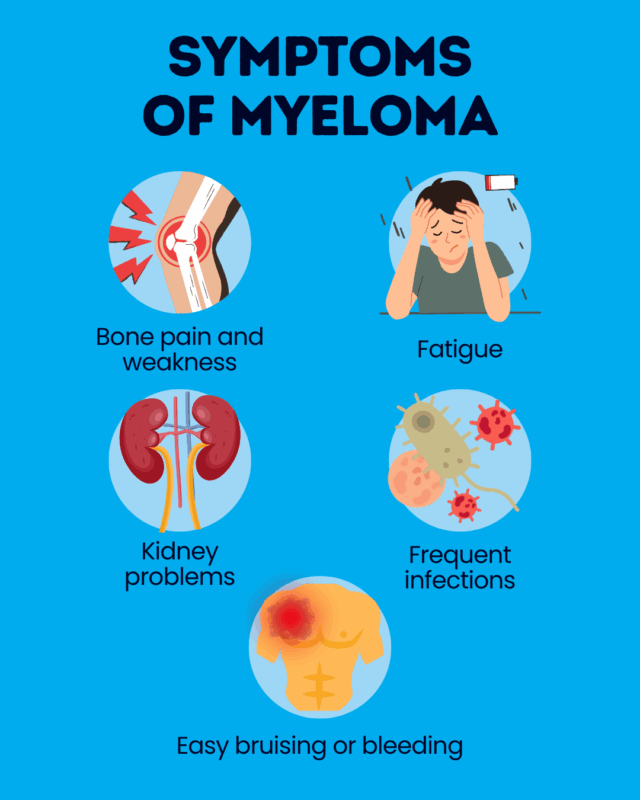
Symptoms of myeloma
Last updated Oct 24, 2025, by Lindsey Shapiro, PhD

The core symptoms of myeloma arise when cancerous cells and the abnormal proteins they produce damage and interfere with the usual function of various body systems and tissues, including the bones, kidneys, nerves, and immune system.
While the exact causes of myeloma are not established, it occurs when antibody-producing immune cells called plasma cells start to grow out of control in the bone marrow, the spongy center of bones where blood cells are produced.
Cancerous plasma cells, or myeloma cells, crowd out healthy blood cells in the bone marrow. They also produce an abnormal antibody called M protein that drives damage to various tissues. Myeloma is often called multiple myeloma, because the disease usually affects more than one area in the bone marrow.
Myeloma symptoms can vary across different individuals. Recognizing the possible signs of myeloma and seeking prompt medical attention is key to ensuring an early diagnosis and treatment for this rare blood cancer.
Common symptoms of myeloma
Myeloma often does not cause any symptoms at first, which is one reason why reaching a myeloma diagnosis can be difficult in the earliest stages. As abnormal plasma cells continue to accumulate and M protein levels rise, symptoms may include:
- bone problems
- fatigue, weakness, and shortness of breath
- frequent infections
- easy bruising or bleeding
- kidney problems.
Myeloma cancer cells form masses that disrupt normal bone structures and lead to overactivity of other cells that break down bone, causing damage. As such, most people with multiple myeloma — up to around 80% — experience bone problems and related issues such as:
- bone pain, commonly in the spine, pelvis, ribs, and skull, which may be mild or severe
- weak bones (osteoporosis)
- vulnerability to bone fractures
- elevated level of calcium in the blood (hypercalcemia), when damaged bones release excess calcium into the bloodstream.
Other common myeloma symptoms arise because myeloma cells have overrun healthy blood cells in the bone marrow. These include:
- Anemia, or a lack of healthy red blood cells, leads to multiple myeloma fatigue, weakness, dizziness, or shortness of breath. More than 60% of people with myeloma are anemic at the time of diagnosis.
- Frequent infections occur due to a lack of healthy white blood cells that normally fight infections, with myeloma patients being about 15 times more susceptible to infection than people without it.
- Easy bruising or bleeding due to low levels of platelets, the blood cell fragments involved in blood clotting.
The kidneys, which are responsible for filtering waste from the blood, become overworked in myeloma due to the high levels of calcium and M protein in circulation. More than half of people with myeloma experience kidney impairments, which can result in kidney failure. Kidney issues may not have symptoms and are detected in blood tests. Possible signs include:
- reduced urine output
- excessive thirst
- swelling in the legs
- appetite changes.

Other possible symptoms
Several other myeloma symptoms are also possible, including:
- symptoms derived from hypercalcemia, including confusion, high blood pressure, nausea or vomiting, constipation, and excessive thirst and urination
- nerve damage, or neuropathy, with symptoms including numbness, tingling, or burning sensations in the hands and feet
- sudden severe back pain and numbness and weakness in the legs due to spinal cord compression
- overly thick blood (hyperviscosity), with such symptoms as confusion, dizziness, weakness, and slurred speech
- reduced appetite and weight loss related to elevated calcium and kidney issues.
High levels of M protein in the blood cause it to thicken, and symptoms of hyperviscosity are related to slowed blood flow to the brain. Neuropathy in myeloma occurs because the M protein is also toxic to nerve cells.
Spinal cord compression happens because of weakened bones in the spine that collapse and press on spinal nerves.
Symptom patterns and disease progression
Myeloma can manifest differently between patients, and not every person will experience all of these myeloma symptoms. Symptoms can also vary based on how advanced or aggressive the cancer is, as well as the disease type.
Before a person is diagnosed with active myeloma, they usually go through precancerous disease stages where plasma cells, and sometimes M protein, start to be elevated, but haven’t reached levels sufficient to cause the tissue damage that drives myeloma symptoms.
- Monoclonal gammopathy of undetermined significance, or MGUS, is an early asymptomatic phase where low numbers of abnormal plasma cells are present but not at levels sufficient to cause damage.
- Smoldering myeloma is an intermediate asymptomatic phase where levels of plasma cells are even higher, but still not to the point where they cause any symptoms.
- In active myeloma, symptoms begin to appear because abnormal plasma cells are causing damage.
There is no defined timeline for MGUS or smoldering myeloma to progress to active, symptomatic myeloma, and they don’t always do so. While myeloma symptoms may appear gradually, certain complications like spinal cord compression could appear abruptly.
When to seek medical attention
Although there’s no definitive strategy for preventing multiple myeloma, recognition of the early symptoms of myeloma is key for enabling a prompt diagnosis and treatment to improve a person’s prognosis.
Several possible symptoms, like myeloma bone pain, fatigue, or constipation, can be subtle and nonspecific. But individuals should always reach out to a healthcare provider any time they are experiencing persistent or unexplained symptoms so that an underlying cause can be identified.
Certain myeloma symptoms, including those related to spinal cord compression, hyperviscosity, or kidney failure, are medical emergencies. Individuals experiencing possible symptoms of these complications should seek immediate medical care.
Rare Cancer News is strictly a news and information website about the disease. It does not provide medical advice, diagnosis, or treatment. This content is not intended to be a substitute for professional medical advice, diagnosis, or treatment. Always seek the advice of your physician or other qualified health provider with any questions you may have regarding a medical condition. Never disregard professional medical advice or delay in seeking it because of something you have read on this website.
Recent Posts
- Vyriad targets 2026 clinical trial for new experimental cell therapy VV169
- Olverembatinib and chemo show deep response in trial for Ph-positive ALL
- Pancreatic cancer treatment atebimetinib set for Phase 3 trial
- 1st trial participant receives Alpha DaRT radiation therapy for glioblastoma
- How my reflection has changed since becoming a caregiver





